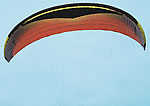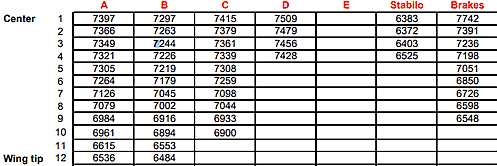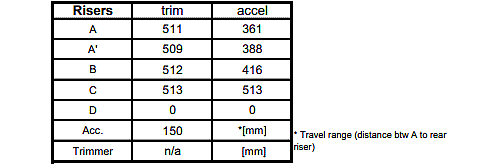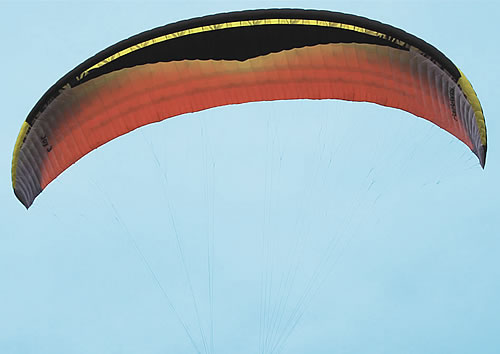Параплан JOY3 PARAAVIS EN-A
- Информация о материале
- Обновлено: 30.01.2024, 10:33
- Опубликовано: 20.10.2022, 07:03
- Автор: DeniS
 Крыло для начинающих пилотов, пилотов выходного дня и маршрутных полетов.
Крыло для начинающих пилотов, пилотов выходного дня и маршрутных полетов.
Joy-3 сертифицирован EN-A, но с уверенностью может быть отнесён к крыльям с лучшим аэродинамическим качеством в классе En-B.
Параплан JOY3 предназначен для:
- выпускников лётных школ;
- пилотов выходного дня;
- опытных пилотов, в том числе со спортивными амбициями, отдающим предпочтение безопасности;
- Joy-3 также будет интересен для пилотов, сочетающих свободные и моторные полёты.
Параплан Joy-3 имеет 59 секций, что является рекордом для данного класса крыльев. Дополнительные секции заметно уменьшили количество дефектов «мягкого крыла» по всему размаху и в особенности на концевых частях параплана.
4-х точечноое стропление центральных нервюр для лучшей аэродинамики параплана на малых скоростях (при зажатых клевантах).
Профиль «агрессивный SharkNose»
Самым большим преимуществом Joy-3 является его комфорт и задемпфированность в реальном турбулентном воздухе. В полёте параплан чрезвычайно хорошо наполнен, монолитен в поворотах, без лишней нервозности и подскладываний реагирует на удары воздуха. При приближении к восходящим или нисходящим потокам Joy-3 плавно изменяет воздушную скорость без резких скачков по крену и тангажу. В умеренной турбулентности Joy-3 стабильно остаётся над головой, не меняя курса и положения, не нервирует и не требует постоянных ответных действий со стороны пилота.
После сложений, срывов и в других внештатных ситуациях возвращение в нормальный управляемый полёт у Joy-3 происходит с минимальными клевками, кренами и углами разворота. Несмотря на то, что параплан благодаря своей высокой степени пассивной безопасности был подтвержден сертификацией с оценкой EN-A (для размера M), сравнительные полеты показывают, что Joy-3 с уверенностью может быть отнесён к крыльям с лучшим аэродинамическим качеством в классе En-B

Технические характеристики параплана JOY3
|
Размер |
XXS |
XS |
S |
M |
L |
XL |
|
Удлинение |
5,7 |
5,7 |
5,7 |
5,7 |
5,7 |
5,7 |
|
Размах, м |
11,07 |
11,37 |
11,94 |
12,47 |
12,99 |
13,5 |
|
Площадь в проекции, кв. м. |
18,12 |
19,13 |
21,06 |
23 |
24,94 |
26,94 |
|
Удлинение в проекции |
4,1 |
4,1 |
4,1 |
4,1 |
4,1 |
4,1 |
|
Размах в проекции, м |
8,61 |
8,85 |
9,3 |
9,71 |
10,11 |
10,51 |
|
Число секций |
59 |
59 |
59 |
59 |
59 |
59 |
|
Высота стропления, м |
6 |
6,17 |
6,48 |
6,77 |
7,05 |
7,33 |
|
Длина строп, м |
240 |
245 |
257 |
269 |
280 |
291 |
|
Полётный вес, кг |
55−75 |
60−80 |
75−95 |
85−105 |
95−115 |
105−135 |
|
Масса крыла, кг |
4,4 |
4,6 |
5 |
5,4 |
5,8 |
6,3 |
|
Площадь**,м2 |
21,5 |
22,7 |
25 |
27,3 |
29,6 |
32 |
|
Центральная хорда, м |
2,39 |
2,46 |
2,58 |
2,69 |
2,80 |
2,92 |
|
Ушная хорда, м |
0,63 |
0,65 |
0,68 |
0,71 |
0,74 |
0,77 |
|
Масштабный коэф. % |
0,93 |
0,953 |
1 |
1,045 |
1,088 |
1,131 |
|
Диаметры строп, мм |
0.5/0.6/0.8/1.1/1.2/2.0 |
0.5/0.6/0.8/1.1/1.2/2.0 |
0.5/0.6/0.8/1.1/1.2/2.0 |
0.5/0.6/0.8/1.1/1.2/2.0 |
0.5/0.6/0.8/1.1/1.2/2.0 |
0.5/0.6/0.8/1.1/1.2/2.0 |
Материалы
|
Производитель |
Материал |
Артикул |
|
|
Верхняя поверхность (консоли, хвост) |
NCV Industries / Dominico Tex |
DOKDO-30DMF |
9017(E25A) |
|
Стропление, верхние ярусы |
Rosenberger AG |
Liros DC 60, DC 100 |
|
|
Стропление, нижние ярусы |
Rosenberger AG |
Liros PPSL 190 / PPSL 200 (L,XL) |
|
|
Верхняя поверхность ( лоб) |
NCV Industries / Dominico Tex |
DOKDO-30DMF |
9017(E25A) |
|
Нервюры, косынки, крылья |
NCV Industries / Dominico Tex |
DOKDO-3MF |
9017(E29A) |
|
Управление, верхний, средний ярус |
Rosenberger AG |
Liros DC 40 |
|
|
Усиления петель |
NCV Industries |
2420 |
X15A |
|
Петли строп |
ОАО «Лента» |
ЛТКП-15−185 |
|
|
Свободные концы |
Güth & Wolf |
Dyneema Core 70 404−15 |
|
|
Нитки (купол, стропы) |
Amann Group |
Nylon 46/2 |
|
|
Нитки (купол, свободные концы) |
Amann Group |
Nylon 69 |
|
|
Нижняя поверхность |
NCV Industries / Dominico Tex |
DOKDO-30DMF |
9017(E25A) |
|
Усиление передней кромки |
Champion |
Леска нейлон d=2мм |
СЕРТИФИКАЦИЯ ПАРАПЛАНА JOY3
https:// para-test.com/reports/item/3847-paraavis-joy-3-m
*************************************************************

Flight test report: EN 926-2:2013 & LTF 91/09
|
Manufacturer Address |
ParAAvis Co. 17A/2 st.lskry |
Certification number Flight test |
PG 1297.2018 31.01.2018 |
|
129344 Moscow Russia |
|||
|
Glider model |
Joy 3M |
Classification |
A |
|
Serial number |
J-5110 |
Representative |
None |
|
Trimmer |
no |
Place of test |
Villeneuve |
|
Folding lines used |
no |
|
Test pilot Harness |
Claude Thurnheer Niviuk- Hamak M |
Alain Zoller Gin Gliders - Gingo 2 L |
||
|
Harness to risers distance (em) |
44 |
43 |
||
|
Distance between risers (em) |
44 |
46 |
||
|
Total weight in flight (kg) |
85 |
105 |
||
|
1.Inflation/Take-off |
A |
|||
|
Rising behaviour |
Smooth, easy and constant rising |
A |
Smooth, easy and constant rising |
A |
|
Specialtake off technique required |
No |
A |
No |
A |
|
2.Landing |
A |
|||
|
Speciallanding technique required |
No |
A |
No |
A |
|
3.Speed in straight flight |
A |
|||
|
Trim speed more than 30 km/h |
Yes |
A |
Yes |
A |
|
Speed range using the controls larger than 10 kmlh |
Yes |
A |
Yes |
A |
|
Minimum speed |
Less than 25 km/h |
A |
Less than 25 km/h |
A |
|
4.Control movement |
A |
|||
|
Max. weight in flight up to 80 kg |
||||
|
Symmetric controlpressure I travel |
not available |
0 |
not available |
0 |
|
Max. weight in flight 80 kg to 100 kg |
||||
|
Symmetric controlpressure I travel |
Increasing I greater than 60 em |
A |
not available |
0 |
|
Max. weight in flight greater than 100 kg |
||||
|
Symmetric controlpressure I travel |
not available |
0 |
Increasing I greater than 65 em |
A |
|
5.Pitch stability exiting accelerated flight |
A |
|||
|
Dive forward angle on exit |
Dive forward less than 30° |
A |
Dive forward less than 30° |
A |
|
Collapse occurs |
No |
A |
No |
A |
|
6.Pitch stability operating controls during accelerated flight |
A |
|||
|
Collapse occurs |
No |
A |
No |
A |
|
7.Roll stability and damping |
A |
|||
|
Oscillations |
Reducing |
A |
Reducing |
A |
|
8.Stability in gentle spirals |
A |
|||
|
Tendency to return to straight flight |
Spontaneous exit |
A |
Spontaneous exit |
A |
|
9.Behaviour exiting a fully developed spiral dive |
A |
|||
|
Initial response of glider (first 180°) |
Immediate reduction of rate ofturn |
A |
Immediate reduction of rate ofturn |
A |
|
Tendency to return to straight flight |
Spontaneous exit (g force decreasing, rate ofturn decreasing) |
A |
Spontaneous exit (g force decreasing, rate ofturn decreasing) |
A |
|
Turn angle to recover nonmal flight |
Less than 720°, spontaneous |
A |
Less than 720°, spontaneous |
A |
|
recovery |
recovery |
|||
|
10. Symmetric front collapse |
A |
|||
|
Approximately 30 % chord |
Rocking back less than 45° |
A |
Rocking back less than 45° |
A |
|
Recovery |
Spontaneous in less than 3 s |
A |
Spontaneous in less than 3 s |
A |
Test Report generated automatically by AIR TURQUOISE SA, valid without signature RE | rev 05 | 16.04.2018 // ISO | 71.8.2 // Page 1 of 3
|
Dive forward angle on exit Change of course |
Dive forward oo to 30° Keeping course |
A |
Dive forward oo to 30° Keeping course |
A |
|
Cascade occurs |
No |
A |
No |
A |
|
Folding lines used |
No |
No |
||
|
At least 50% chord |
||||
|
Entry |
Rocking back less than 45° |
A |
Rocking back less than 45° |
A |
|
Recovery |
Spontaneous in less than 3 s |
A |
Spontaneous in less than 3 s |
A |
|
Dive forward angle on exit I Change of course |
Dive forward oo to 30° I Keeping |
A |
Dive forward oo to 30° I Keeping |
A |
|
course |
course |
|||
|
Cascade occurs |
No |
A |
No |
A |
|
Folding lines used |
No |
No |
||
|
With accelerator |
||||
|
Entry |
Rocking back less than 45° |
A |
Rocking back less than 45° |
A |
|
Recovery |
Spontaneous in less than 3 s |
A |
Spontaneous in less than 3 s |
A |
|
Dive forward angle on exit I Change of course |
Dive forward oo to 30° I Keeping |
A |
Dive forward oo to 30° I Keeping |
A |
|
course |
course |
|||
|
Cascade occurs |
No |
A |
No |
A |
|
Folding lines used |
No |
No |
||
|
11. Exiting deep stall (parachutalstall) |
A |
|||
|
Deep stall achieved |
Yes |
A |
Yes |
A |
|
Recovery |
Spontaneous in less than 3 s |
A |
Spontaneous in less than 3 s |
A |
|
Dive forward angle on exit |
Dive forward oo to 30° |
A |
Dive forward oo to 30° |
A |
|
Change of course |
Changing course less than 45° |
A |
Changing course less than 45° |
A |
|
Cascade occurs |
No |
A |
No |
A |
|
12. High angle of attack recovery |
A |
|||
|
Recovery |
Spontaneous in less than 3 s |
A |
Spontaneous in less than 3 s |
A |
|
Cascade occurs |
No |
A |
No |
A |
|
13. Recovery from a developed full stall |
A |
|||
|
Dive forward angle on exit |
Dive forward oo to 30° |
A |
Dive forward oo to 30° |
A |
|
Collapse |
No collapse |
A |
No collapse |
A |
|
Cascade occurs (other than collapses) |
No |
A |
No |
A |
|
Rocking back |
Less than 45° |
A |
Less than 45° |
A |
|
Line tension |
Most lines tight |
A |
Most lines tight |
A |
|
14. Asymmetric collapse |
A |
|||
|
Small asymmetric collapse |
||||
|
Change of course until re-inflation I Maximum dive forward or |
Less than goo I Dive or roll angle |
A |
Less than goo I Dive or roll angle |
A |
|
roll angle |
15oto 45o |
oo to 15° |
||
|
Re-inflation behaviour |
Spontaneous re-inflation |
A |
Spontaneous re-inflation |
A |
|
Total change of course |
Less than 360° |
A |
Less than 360° |
A |
|
Collapse on the opposite side occurs |
No (or only a small number of |
A |
No (or only a small number of |
A |
|
collapsed cells with a spontaneous |
collapsed cells with a spontaneous |
|||
|
reinflation) |
reinflation) |
|||
|
Twist occurs |
No |
A |
No |
A |
|
Cascade occurs |
No |
A |
No |
A |
|
Folding lines used |
No |
No |
||
|
Large asymmetric collapse |
||||
|
Change of course until re-inflation I Maximum dive forward or |
Less than goo I Dive or roll angle |
A |
Less than goo I Dive or roll angle |
A |
|
roll angle |
15° to 45° |
15° to 45° |
||
|
Re-inflation behaviour |
Spontaneous re-inflation |
A |
Spontaneous re-inflation |
A |
|
Total change of course |
Less than 360° |
A |
Less than 360° |
A |
|
Collapse on the opposite side occurs |
No (or only a small number of |
A |
No (or only a small number of |
A |
|
collapsed cells with a spontaneous |
collapsed cells with a spontaneous |
|||
|
reinflation) |
reinflation) |
|||
|
Twist occurs |
No |
A |
No |
A |
|
Cascade occurs |
No |
A |
No |
A |
|
Folding lines used |
No |
No |
||
|
Small asymmetric collapse with fully activated accelerator |
||||
|
Change of course until re-inflation I Maximum dive forward or roll angle |
Less than goo I Dive or roll angle 15o to45o |
A |
Less than goo I Dive or roll angle oo to 15° |
A |
|
Re-inflation behaviour |
Spontaneous re-inflation |
A |
Spontaneou s re-inflation |
A |
|
Total chan ge of course |
Less than 360° |
A |
Less than 360° |
A |
Test Report generated automatically by AIR TURQUOISE SA, valid without signature RE | rev 05 | 16.04.2018 // ISO | 71.8.2 // Page 2 of 3
|
Collapse on the opposite side occurs |
No (or only a small number of collapsed cells with a spontaneous |
A |
No (or only a small number of collapsed cells with a spontaneous |
A |
|
reinflation) |
reinflation) |
|||
|
Twist occurs |
No |
A |
No |
A |
|
Cascade occurs |
No |
A |
No |
A |
|
Folding lines used |
No |
No |
||
|
Large asymmetric collapse with fully activated accelerator |
||||
|
Change of course until re-inflation I Maximum dive forward or roll angle |
Less than goo I Dive or roll angle 15° to 45° |
A |
Less than goo I Dive or roll angle 15° to 45° |
A |
|
Re-inflation behaviour |
Spontaneous re-inflation |
A |
Spontaneous re-inflation |
A |
|
Total change of course |
Less than 360° |
A |
Less than 360° |
A |
|
Collapse on the opposite side occurs |
No (or only a small number of |
A |
No (or only a small number of |
A |
|
collapsed cells with a spontaneous |
collapsed cells with a spontaneous |
|||
|
reinflation) |
reinflation) |
|||
|
Twist occurs |
No |
A |
No |
A |
|
Cascade occurs |
No |
A |
No |
A |
|
Folding lines used |
No |
No |
||
|
15. Directionalcontrol with a maintained asymmetric |
A |
|||
|
collapse |
||||
|
Able to keep course |
Yes |
A |
Yes |
A |
|
180° tum away from the collapsed side possible in 10 s |
Yes |
A |
Yes |
A |
|
Amount of control range between turn and stall or spin |
More than 50 % of the symmetric |
A |
More than 50 % of the symmetric |
A |
|
controltravel |
control travel |
|||
|
16. Trim speed spin tendency |
A |
|||
|
Spin occurs |
No |
A |
No |
A |
|
17. Low speed spin tendency |
A |
|||
|
Spin occurs |
No |
A |
No |
A |
|
18. Recovery from a developed spin |
A |
|||
|
Spin rotation angle after release |
Stops spinning in less than goo |
A |
Stops spinning in less than goo |
A |
|
Cascade occurs |
No |
A |
No |
A |
|
19. B-llne stall |
A |
|||
|
Change of course before release |
Changing course less than 45° |
A |
Changing course less than 45° |
A |
|
Behaviour before release |
Remains stable with straight span |
A |
Remains stable with straight span |
A |
|
Recovery |
Spontaneous in less than 3 s |
A |
Spontaneous in less than 3 s |
A |
|
Dive forward angle on exit |
Dive forward oo to 30° |
A |
Dive forward oo to 30° |
A |
|
Cascade occurs |
No |
A |
No |
A |
|
20. Big ears |
A |
|||
|
Entry procedure |
Dedicated controls |
A |
Dedicated controls |
A |
|
Behaviour during big ears |
Stable flight |
A |
Stable flight |
A |
|
Recovery |
Spontaneous in less than 3 s |
A |
Spontaneous in less than 3 s |
A |
|
Dive forward angle on exit |
Dive forward oo to 30° |
A |
Dive forward oo to 30° |
A |
|
21. Big ears in accelerated flight |
A |
|||
|
Entry procedure |
Dedicated controls |
A |
Dedicated controls |
A |
|
Behaviour during big ears |
Stable flight |
A |
Stable flight |
A |
|
Recovery |
Spontaneous in less than 3 s |
A |
Spontaneous in less than 3 s |
A |
|
Dive forward angle on exit |
Dive forward oo to 30° |
A |
Dive forward oo to 30° |
A |
|
Behaviour immediately after releasing the accelerator while |
Stable flight |
A |
Stable flight |
A |
|
maintaining big ears |
||||
|
22. Alternative means of directional control |
A |
|||
|
180° turn achievable in 20 s |
Yes |
A |
Yes |
A |
|
Stall or spin occurs |
No |
A |
No |
A |
|
23. Any other flight procedure and/or configuration |
0 |
|||
|
described in the user's manual |
||||
|
Procedure works as described |
not available |
0 |
not available |
0 |
|
Procedure suitable for novice pilots |
not available |
0 |
not available |
0 |
|
Cascade occurs |
not available |
0 |
not available |
0 |
|
24. Comments oftest pilot |
Test Report generated automatically by AIR TURQUOISE SA, valid without signature RE | rev 05 | 16.04.2018 // ISO | 71.8.2 // Page 3 of 3
*************************************************************

PG MEASUREMENT REPORT
MEASUREMENT OF FLIGHT TEST SAMPLE
| Report number : PG_1297.2018 | Sample name: Joy 3 M |
| Manufacturer : ParAAvis Co. | S/N: J-5110 |
TOTAL LINE LENGTH WITH RISER [mm]

MEASUREMENT TOTAL RISER LENGTH [mm] (without carabiners)

GB | REV 03 | 24.03.2016 Page 1 | 1 ISO I 71.4.3P

